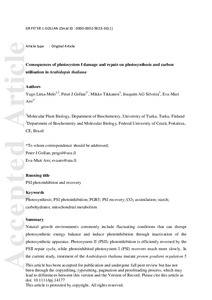Consequences of photosystem‐I damage and repair on photosynthesis and carbon use in Arabidopsis thaliana
Joaquim A. G. Silveira; Yugo Lima‐Melo; Eva‐Mari Aro; Mikko Tikkanen; Peter J. Gollan
https://urn.fi/URN:NBN:fi-fe2021042720194
Tiivistelmä
Natural growth environments commonly include fluctuating conditions that can disrupt the photosynthetic energy balance and induce photoinhibition through inactivation of the photosynthetic apparatus. Photosystem II (PSII) photoinhibition is efficiently reversed by the PSII repair cycle, whereas photoinhibited photosystem I (PSI) recovers much more slowly. In the current study, treatment of the Arabidopsis thaliana mutant proton gradient regulation 5 (pgr5) with excess light was used to compromise PSI functionality in order to investigate the impact of photoinhibition and subsequent recovery on photosynthesis and carbon metabolism. The negative impact of PSI photoinhibition on CO2 fixation was especially deleterious under low irradiance. Impaired starch accumulation after PSI photoinhibition was reflected in reduced respiration in the dark, but this was not attributed to impaired sugar synthesis. Normal chloroplast and mitochondrial metabolisms were shown to recover despite the persistence of substantial PSI photoinhibition for several days. The results of this study indicate that the recovery of PSI function involves the reorganization of the light‐harvesting antennae, and suggest a pool of surplus PSI that can be recruited to support photosynthesis under demanding conditions.
Kokoelmat
- Rinnakkaistallenteet [19207]
